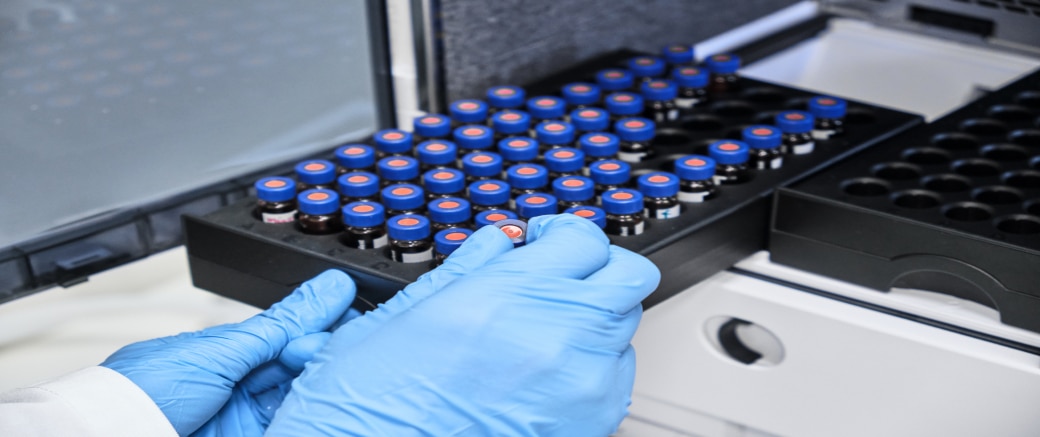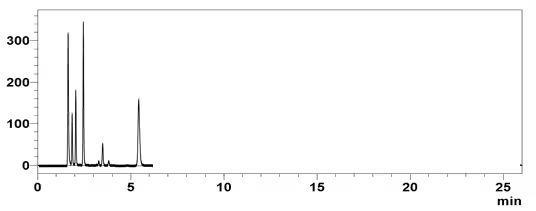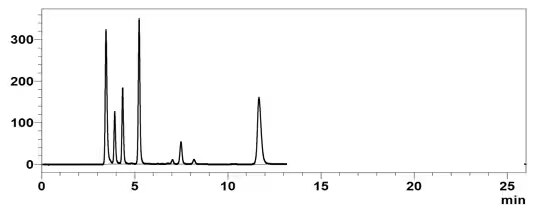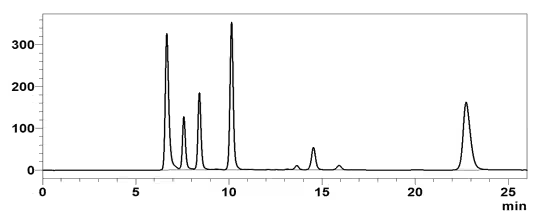Fundamentals of High Performance Liquid Chromatography (HPLC)
Key Considerations and Analysis Solutions

High performance liquid chromatography (HPLC) is an advanced analytical method, where "chromatography" is a technique for separation, while "chromatogram" is the result of chromatography, and "chromatograph" is the instrument used to conduct chromatography.
Among the various technologies developed for chromatography, devices dedicated for molecular separation called columns and high-performance pumps for delivering solvent at a stable flow rate are some of the key components of chromatographs. As related technologies evolved to become more sophisticated, the system commonly referred to as High Performance Liquid Chromatography, simply became referred to as "LC". Nowadays, Ultra High Performance Liquid Chromatography (UHPLC), capable of high-speed analysis, has also become widely used.
Only compounds dissolved in solvents can be analyzed with HPLC. The HPLC method separates compounds dissolved in a liquid sample and allows qualitative and quantitative analysis of what components and how much of each component are contained in the sample.
Explore further to gain insights into the fundamentals of HPLC and its diverse applications in analyzing complex mixtures!
Or, jump ahead by accessing all about LC in the Resource Library.
LC Technology Techniques & Tips
How High Performance Liquid Chromatography (HPLC) Works
HPLC can separate and detect each compound by the difference of each compound's speed through the column.
There are two phases for HPLC: the mobile and stationary phases. The mobile phase is the liquid that dissolves the target compound. The stationary phase is the part of a column that interacts with the target compound.
In the column, the stronger the affinity (e.g.; van der waals force) between the component and the mobile phase composition, the faster the component moves through the column along with the mobile phase. On the other hand, the stronger the affinity with the stationary phase, the slower it moves through the column. The elution speed in the column depends on the affinity between the compound and the stationary phase, and hence enables the separation of the different compounds in the mixture.
General HPLC Separation Modes
| Separation Mode | Interaction | Components |
|---|---|---|
| Reversed phase chromatography (RP) | Hydrophobicity (Low Polarity) | Small molecule pharmaceuticals, Vitamins, etc. |
| Normal phase chromatography (NP) | Hydrophilicity (High Polarity) | Saccharides, Nuclear acids, etc. |
| Ion exchange chromatography (IEX) | Electrostaticity | Inorganic ions, Amino acids, Protein, etc. |
| Size exclusion chromatography (SEC) | Molecular size | Synthetic polymer, Biopolymer, Polysaccharide, etc. |
Key Considerations of High Performance Liquid Chromatography
An effective HPLC analysis solution calls for a well-designed chromatographic separation system tailored to the analysis requirements. Here are some factors to consider for a typical HPLC separation:
- Isocratic vs Gradient Elution Modes
Isocratic Elution
- A single composition of solvents is used for the duration of the separation
- Later eluting peaks are broader than earlier eluting peaks because of dispersion
- Steps must be taken to periodically flush the column at higher solvent strength to clean it of intractable materials that build up from sample injections
Gradient Elution
- The composition of solvents is changed either continuously or stepwise
- In general, peaks are sharper throughout the chromatogram when compared to isocratic elution
- Some separations may be achieved which are not possible using isocratic elution
- Chromatogram run times may be shorter when compared to isocratic elution
- LC Columns
The selection of the stationary phase, often C18 or other bonded phases, affects the selectivity and efficiency of the separation process. Varied column dimensions and particle sizes can also influence resolution and the speed of analysis. Some key considerations and questions to ask include:
- What is the sample solubility and chemical differences between the sample constituents:
- Soluble in organic or aqueous solvents?
- Knowledge of constituent functional groups? -OH; -COOH; -CONH2; -C6H6, etc. - What are the goals for the chromatography?
- Resolution of a critical pair of constituents? – longer column bed
- Fast analysis? – shorter column bed
- Maximum resolution for all? – smaller particles
- Minimize solvent consumption? – narrower inner diameter
- Detectors for HPLC
There are a range of detectors available for monitoring the compounds separated in the column.
- UV/Vis Detectors: Responds to chromophoric analytes (190 – 800 nm) with single-wavelength monitoring, suitable for most organic analytes, and gradient elution compatible.
- Photodiode Array (PDA) Detectors: Responds to chromophoric analytes (190 – 800 nm) with multi-wavelength monitoring, provides complete spectral profiles, suitable for most organic analytes, and gradient elution compatible.
- Fluorescence Detectors: Extremely sensitive, responds to naturally fluorescing or can be made to fluoresce through derivatization, and gradient elution compatible.
- Refractive Index Detectors: Universal detector for all analytes, comparatively insensitive, not compatible with gradient elution.
- Evaporative Light Scattering Detectors: Near-universal detector for chromophoric and non-chromophoric analytes, good sensitivity, and gradient elution compatible.
- Mass Spectrometry Detectors: The most discriminating detector providing mass information for ID and structure elucidation, highly sensitive, and gradient elution compatible.
How To Choose Between HPLC and UHPLC?
Once the decision has been made to purchase an HPLC system, the next decision is to choose between HPLC or ultra-high-performance liquid chromatography (UHPLC) as they each have their own advantages and disadvantages, as summarized below:
| Application Goal | Optimum LC Column Particle Size | System Pressure Tolerance | Chromatogram Run Time | System |
|---|---|---|---|---|
| UHPLC - Highest resolution - Highest throughput - 90 to 120 runs per 8 hr. day - Highest Performance |
1.7 - 5 µm | XS 105 MPa 15,000 PSI X3 130 MPa 19,000 PSI |
|
Nexera XS, X3 Modular |
| UHPLC - High resolution - High throughput - 40 to 60 runs per 8 hr. day - Performance |
3- 5 µm | 66 MPa 10,000 PSI |
|
Nexera XR Modular & Integrated |
| Conventional HPLC - Forgiving for new users - 16 to 24 runs per 8 hr. day - Economy |
5 µm | 42 MPa 6,000 PSI |
|
LC-40 Modular & Integrated |
For the novice user, HPLC is a more robust, rugged methodology. The robustness/ruggedness of an analytical procedure is a measure of its ability to remain unaffected by small, but deliberate variations in method parameters and further indicates its reliability during normal usage. Because of the robustness of HPLC, a novice user can easily perform HPLC analysis from sample preparation to operation, and maintenance. On the other hand, UHPLC demands that the highest quality solvents (UHPLC or LCMS grade) be used and that samples be rigorously filtered of particulates. Therefore UHPLC, while powerful, is far less forgiving than HPLC in this regard.
Besides robustness, the capital cost and operating cost for HPLC are comparatively lower. Instrument costs for HPLC are approximately 20% lower than the UHPLC. Moreover, using HPLC grade solvents can also reduce operating costs, in comparison to UHPLC or LCMS grade solvents. Finally, the maintenance frequency for HPLC is also lower, resulting in a 30-50% reduction in consumables costs (e.g. seals, plungers, autosampler injection valve rotor & stator).
Analysis Solutions Using High Performance Liquid Chromatography
Explore our Technology Solutions to discover analysis solutions using LC. From learning how to achieve better bioseparation with LC columns to getting tips for daily analysis, discover how Shimadzu’s LC solutions offer smarter and simpler solutions to enable quality LC analysis across diverse applications.
Get to access our video resources to explore the how-to guide in HPLC analysis, including the step by step procedure on how to analyze lutein in spinach and ascorbic acids. Moreover, learn from our experts on the practical tips and tricks in setting up an HPLC calibration curve using external standards, all packed under our Resource Library.
For more, discover our Digital Classrooms to discover how to level up your HPLC analysis today.





